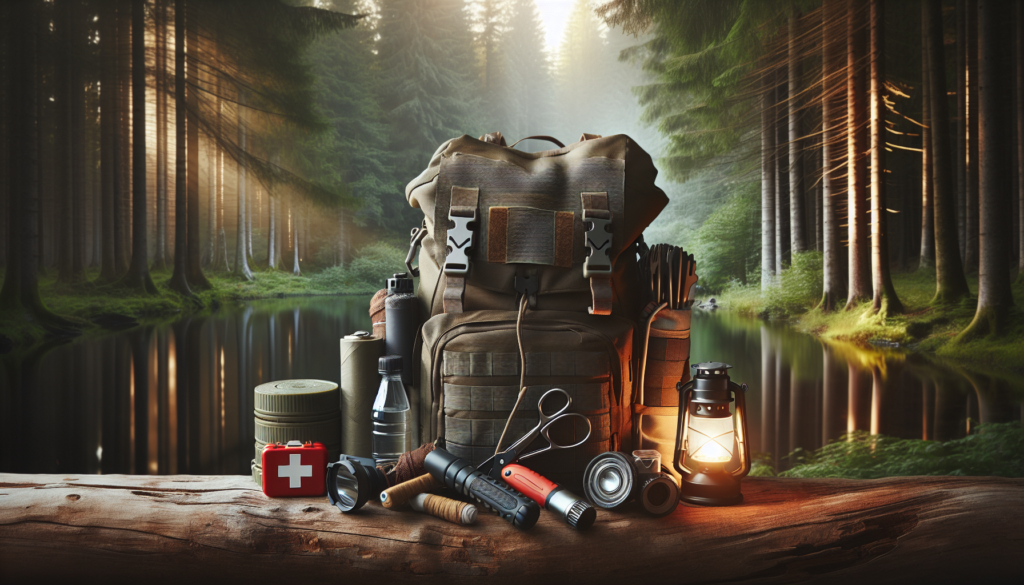In this helpful guide, “Preparedness 101: A Comprehensive Guide to Emergency Preparedness”, you will find everything you need to know about preparing yourself and your loved ones for unexpected emergencies. Whether you’re a beginner or simply looking to refresh your knowledge, this comprehensive guide is packed with valuable information and practical tips to ensure you’re well-equipped to handle any crisis that may come your way. From creating emergency kits to developing communication plans, this guide has got you covered, serving as your go-to resource for all things emergency preparedness.
Define Emergency Preparedness

Understanding the concept
Emergency preparedness refers to the actions taken in anticipation of and response to potential emergencies or disasters. It involves being prepared for various types of emergencies, such as natural disasters, fires, pandemics, or terrorist attacks. The goal of emergency preparedness is to minimize the negative impact of these events by having a plan, necessary supplies, and the knowledge and skills required to act effectively during emergencies.
Importance of emergency preparedness
Emergency preparedness is crucial for everyone, regardless of geographical location or personal circumstances. It is not a matter of if an emergency will occur, but rather when. Being prepared can save lives, reduce injuries, and minimize property damage. It also helps to mitigate the potential chaos that can result from a lack of preparedness. By investing time and effort into emergency preparedness, you can enhance your ability to respond and recover from emergencies, ensuring the safety and well-being of yourself, your loved ones, and your community.
Assessing Risks and Hazards
Identifying potential risks
The first step in emergency preparedness is to identify potential risks and hazards in your area. This can include natural disasters such as earthquakes, hurricanes, floods, or wildfires, as well as other hazards like chemical spills or power outages. Understanding the specific risks in your region allows you to plan and prepare accordingly.
Understanding different types of emergencies
Emergencies can take various forms and require different responses. Familiarize yourself with the different types of emergencies that could occur, such as severe weather events, medical emergencies, or civil unrest. Each type of emergency may require unique preparations and response strategies.
Assessing local hazards
Research and assess the specific hazards prevalent in your local area. Take into account factors like geographical location, climate, proximity to bodies of water, and the likelihood of certain events. For example, if you live in a coastal area, you may need to prepare for hurricanes or tsunamis. Understanding the specific hazards you face will help you tailor your emergency preparedness plans to your environment.
Evaluating personal vulnerabilities
In addition to assessing external risks and hazards, it is essential to evaluate your personal vulnerabilities. Consider factors such as age, health conditions, mobility limitations, and the needs of family members or dependents. By understanding your vulnerabilities, you can address them specifically when developing your emergency plans and kits.
Creating a Personal Emergency Plan
Establishing a family emergency plan
A family emergency plan serves as a blueprint for how your household will respond to different emergencies. It should include designated roles and responsibilities for each family member, communication strategies, evacuation procedures, and meeting points. Develop your plan based on the specific needs and circumstances of your household.
Designating meeting points
Identify multiple meeting points both within your neighborhood and outside of it. Having predetermined meeting points ensures that family members can reunite if communication systems are disrupted during emergencies. Choose easily recognizable locations, such as a neighbor’s house, a park, or a community center.
Identifying emergency contacts
Compile a list of emergency contacts, including phone numbers for local authorities, hospitals, and family members or friends who reside outside of your immediate area. Save these contacts in your phone, write them down in a physical notebook, and provide copies to each family member.
Preparing emergency kits
Emergency kits, also known as “go bags” or “bug-out bags,” are essential in emergency preparedness. These kits should contain basic necessities such as food, water, clothing, medications, and important documents. Customize your kits to meet the specific needs of your family members and consider factors like climate, duration, and potential emergencies.
Developing communication strategies
Establish communication strategies both within your household and with external parties. Designate a central point of contact or a communication hub to stay informed about the latest developments and relay information to family members. Determine alternate forms of communication, such as texting or utilizing social media platforms, in case traditional communication methods are unavailable.
Emergency Evacuation
Understanding evacuation procedures
During certain emergencies, evacuation may be necessary to ensure safety. Familiarize yourself with the evacuation procedures established by local authorities. Understand the different evacuation levels or zones and the corresponding instructions associated with each level. Follow these instructions promptly and calmly when directed to evacuate.
Preparing evacuation routes
Identify primary and alternative evacuation routes from your home or workplace to designated safe zones. Consider factors such as traffic patterns, possible road closures, and accessibility for different modes of transportation. Practice these evacuation routes regularly with your family to ensure everyone is familiar with the directions.
Determining safe zones
Safe zones are locations designated by authorities that provide shelter, resources, and assistance during emergencies. Research and familiarize yourself with the safe zones in your community, such as schools, community centers, or designated emergency shelters. Understand the conditions under which these safe zones are activated and the procedures for accessing them.
Considerations for pet evacuation
If you have pets, ensure you have a plan in place for their evacuation and care during emergencies. Identify pet-friendly shelters or boarding facilities in your area and include necessary supplies such as food, water, medication, and veterinary records in your pet’s emergency kit. Have a plan for transportation and ensure your pets are properly identified with tags and microchips.
Special considerations for individuals with disabilities
People with disabilities may require additional support and accommodations during emergencies. Take into account the specific needs of individuals with disabilities in your household or community when developing emergency plans. Ensure you have the necessary equipment, supplies, and communication strategies in place to address these needs effectively.
Building Emergency Kits
Essential items for emergency kits
Emergency kits should include essential items that can sustain you and your family during an emergency situation. These items may include non-perishable food, water, clothing, blankets, flashlight, batteries, a multi-tool, duct tape, a whistle, and a first aid kit. Customize your emergency kits based on the specific needs of your household.
Food and water supplies
Stock your emergency kit with an adequate supply of non-perishable food items. Include items such as canned goods, protein bars, dried fruits, nuts, and other foods with a long shelf life. Remember to regularly check and rotate these supplies to ensure freshness.
Water is essential for survival during emergencies. Store at least one gallon of water per person per day for a minimum of three days. Consider additional water supplies for sanitation purposes, such as cleaning and hygiene.
First aid supplies
A comprehensive first aid kit is essential in any emergency preparedness plan. It should include items such as bandages, adhesive tape, antiseptic solutions, pain relievers, tweezers, and emergency medication specific to your family’s needs. Familiarize yourself with basic first aid techniques and consider receiving first aid training.
Personal hygiene items
Maintaining personal hygiene is crucial, even during emergencies. Include items such as toothbrushes, toothpaste, soap, hand sanitizer, menstrual products, and diapers in your emergency kit. These items contribute to your overall well-being and comfort during challenging times.
Important documents and cash reserves
Keep copies of essential documents such as identification cards, passports, insurance policies, medical records, and contact information in a waterproof and easily accessible container. Additionally, have a supply of cash or traveler’s checks on hand, as electronic payment systems may be unavailable during emergencies.
Securing Shelter and Basic Needs

Creating a safe haven at home
During certain emergencies, it may be safer to stay at home rather than evacuate. Take steps to secure your home, such as reinforcing doors and windows, installing smoke detectors and fire extinguishers, and identifying a designated safe room. Ensure you have necessary supplies to sustain yourself and your family for an extended period if access to the outside world is limited.
Securing shelter in public spaces
If you are unable to stay at home, identify nearby public spaces that can serve as temporary shelters during emergencies. These spaces may include schools, community centers, or designated emergency shelters. Research and understand the procedures for accessing these public shelters and what supplies they may provide.
Emergency power sources
Loss of power is a common occurrence during emergencies, which can disrupt essential services and communication. Prepare alternative power sources such as battery-operated lights, generators, or solar chargers for electronic devices. Ensure you have extra batteries or charging cables available to sustain these power sources.
Heating and cooling considerations
Depending on the type of emergency and external conditions, maintaining a comfortable temperature indoors may be challenging. Prepare for heating needs by having extra blankets, warm clothing, and portable heaters or heat packs. For cooling needs, consider portable fans, ice packs, and access to shade or ventilated areas.
Water and sanitation
Access to clean water and sanitation facilities may be compromised during emergencies. Plan for alternative options, such as water storage containers, water purification devices or tablets, and portable toilets or supplies for makeshift sanitation areas. Ensuring access to clean water and proper sanitation is vital for maintaining health and hygiene.
Emergency Food and Water
Stockpiling non-perishable food items
Non-perishable food items are crucial for sustaining yourself and your family during emergencies. Stock your pantry with canned goods, dried fruits, nuts, protein bars, and other foods with a long shelf life. Aim to have a supply that can sustain your household for a minimum of three days, but ideally one to two weeks.
Determining appropriate water storage
Water is a vital resource during emergencies. Determine the appropriate amount of water to store based on the needs of your household, taking into account factors such as climate, individual requirements, and the duration of potential emergencies. Store water in food-grade containers and regularly rotate the supply to ensure freshness.
Water purification methods
If clean, potable water is not readily available, it is important to have the means to purify water for consumption. Invest in water purification devices such as filters or purification tablets to remove contaminants and make water safe to drink. Familiarize yourself with the instructions for these devices and regularly maintain them.
Rotation and expiration of supplies
Regularly check and rotate your emergency food and water supplies to ensure freshness and quality. Label your supplies with expiration dates and use the oldest items first. Stay updated on recalls or changes in food safety recommendations to ensure the integrity of your emergency supplies.
Special considerations for infants and medication
If you have infants, consider their unique nutritional needs when stockpiling emergency food supplies. Include formula, baby food, diapers, and other necessities. If anyone in your household requires medication, ensure you have an adequate supply on hand, as access to pharmacies and medical services may be limited during emergencies. Monitor expiration dates and regularly refill prescriptions.
Emergency Communication
Establishing communication networks
Establishing effective communication networks is crucial during emergencies. Designate a central point of contact within your household to serve as a hub for receiving and relaying information. Ensure everyone in your household knows who this point of contact is and how to reach them.
Family and neighborhood communication plans
Develop communication plans with your extended family, neighbors, and close friends. Share contact information, establish communication protocols, and discuss potential ways to support each other during emergencies. This collaborative approach helps ensure that everyone stays informed and receives necessary assistance.
Using technology during emergencies
Leverage technology to enhance communication during emergencies. Utilize text messaging or social media platforms to stay connected with friends, family, and local authorities. Stay informed about updates, emergency alerts, or evacuation orders through official news sources or dedicated emergency management applications.
Emergency radio and communication devices
Invest in an emergency radio or communication device that can function without electricity or cellular networks. These devices allow you to receive important updates, weather information, and emergency broadcasts. Familiarize yourself with the operation of these devices and keep extra batteries or alternate power sources.
Social media and online resources
During emergencies, social media platforms and online resources can provide valuable information and support. Follow official government accounts, local news outlets, and emergency management agencies on social media for updates and instructions. Participate in online communities or groups dedicated to emergency preparedness to share and gain knowledge from others.
First Aid and Medical Preparedness
Essential first aid supplies
A comprehensive first aid kit is an essential component of emergency preparedness. Ensure your kit contains items such as bandages, sterile dressings, antiseptic solutions, pain relievers, tweezers, scissors, and a first aid manual. Familiarize yourself with the contents of the kit and how to use them correctly.
Basic first aid techniques
In addition to having the necessary supplies, it is important to learn basic first aid techniques. These can include skills such as wound cleaning and dressing, CPR (cardiopulmonary resuscitation), and treating common injuries such as burns or fractures. Consider taking a first aid and CPR training course to enhance your knowledge and skills.
CPR and AED training
Cardiopulmonary resuscitation (CPR) and automated external defibrillator (AED) training are valuable skills that can save lives during medical emergencies, such as heart attacks or drowning incidents. Consider receiving formal CPR and AED training from certified organizations to ensure you are prepared to respond effectively.
Medical emergency preparedness
Prepare for medical emergencies by including relevant medical supplies in your emergency kits. This can include items such as prescription medications, adhesive bandages, antibiotic ointment, and allergy medication. Regularly check expiration dates and refill supplies as needed.
Managing chronic conditions during emergencies
If you or a family member has a chronic medical condition, it is crucial to plan and prepare for emergency scenarios. Consult with healthcare professionals to discuss specific needs and develop strategies for managing chronic conditions during emergencies. Ensure you have an adequate supply of necessary medications, medical devices, and any required support or assistance.
Psychological and Emotional Preparedness
Understanding psychological impact
Emergencies can have a significant psychological impact on individuals and communities. It is important to recognize that emotional and mental well-being are as crucial as physical preparedness. Understand the potential psychological effects of emergencies, such as stress, anxiety, grief, or post-traumatic stress disorder (PTSD).
Coping strategies during emergencies
Develop coping strategies that can help you and your family manage the emotional challenges of emergencies. These may include practicing relaxation techniques, maintaining a regular routine, seeking social support, engaging in activities that bring comfort and joy, and staying informed through credible sources of information.
Recognizing signs of distress
Be aware of signs of distress in yourself and others during and after emergencies. These signs may include changes in behavior, mood swings, sleep disturbances, or difficulty concentrating. Recognize that these reactions are normal under the circumstances and seek professional help if needed.
Support systems and mental health resources
Prioritize building and maintaining support systems within your community. Connect with neighbors, friends, and community organizations to establish networks that can provide emotional support during emergencies. Research and have access to mental health resources, such as hotlines or counseling services, that can offer assistance when needed.
Post-disaster recovery and resilience
Recovering from emergencies is a gradual process that requires resilience and support. Engage in activities that promote resilience, such as maintaining a positive mindset, staying connected with loved ones, and seeking professional help when necessary. Recognize the importance of self-care and permit yourself time to heal and rebuild after an emergency.
In conclusion, emergency preparedness is a vital aspect of ensuring the safety and well-being of yourself, your loved ones, and your community. By understanding the concept of emergency preparedness, assessing risks and hazards, creating a personal emergency plan, and building essential kits, you can enhance your readiness for emergencies. Through familiarity with evacuation procedures, securing shelter and basic needs, preparing for food and water scarcity, establishing communication networks, and being equipped with first aid and medical knowledge, you can confidently respond during emergencies. Additionally, prioritizing psychological and emotional preparedness helps you cope with the challenges and impacts of emergencies. By embracing emergency preparedness, you become an active participant in promoting resilience, safety, and recovery.
